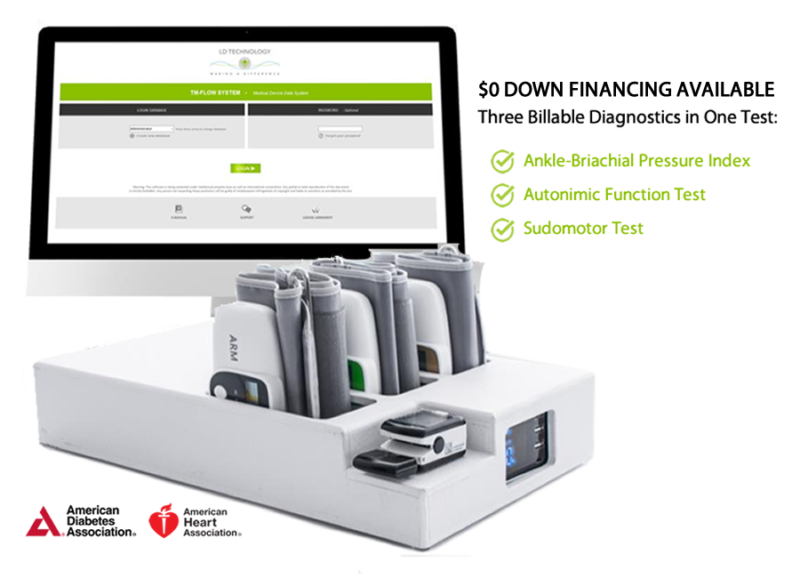Frequently Asked Questions
The TM Flow device offers numerous benefits for medical practices, including non-invasive and accurate testing, early detection of autonomic and arterial dysfunctions, and comprehensive diagnostics that reduce the overall cost of patient care. Additionally, the device’s tests are easy to bill with multi-code diagnostics, making it a valuable investment for enhancing patient care and optimizing practice efficiency. It also supports compliance with standards of care recommended by leading health organizations.
Yes, the TM Flow device is covered by Medicare and most private pay carriers. Specific CPT codes, such as 95921 for cardiovagal innervation and 93923 for ankle-brachial pressure index, ensure that the diagnostics are easy to bill. Coverage and reimbursements may vary depending on the Medicare locality, but the comprehensive diagnostics offered by the TM Flow device are widely recognized and supported by insurance providers.
Autonomic nervous system testing is crucial for diabetes and cardiovascular patients because it helps in the early detection of autonomic neuropathy, which is a common complication in these conditions. Early detection through ANS testing allows for timely intervention and management, reducing the risk of further complications. The American Diabetes Association recommends ANS testing as a standard of care for patients with Type 1 and Type 2 diabetes, highlighting its importance in effective diabetes management.
The TM Flow device is an advanced, non-invasive diagnostic tool designed to perform a series of tests that aid in the identification and early detection of autonomic nervous system (ANS) and arterial dysfunctions. It provides quantitative assessments of the ANS, helping to distinguish between early and late stages of autonomic neuropathy. The TM Flow device is particularly valuable for cardiovascular and diabetic autonomic neuropathy (DAN) testing, making it an essential tool in diabetes management and cardiovascular assessments.
TM Flow in Huntsville
When a patient is experiencing symptoms of peripheral neuropathy, it is important that their doctor can accurately diagnose the condition and then develop an appropriate treatment plan. Some of the more common medical tests used to help diagnose peripheral neuropathy include: – Sudomotor testing – Autonomic reflex screening These tests can accurately determine whether or not your patient may be suffering from any nerve disorders or conditions, including those that are related to diabetes.
When a patient is experiencing symptoms of peripheral neuropathy, it is important that their doctor can accurately diagnose the condition and then develop an appropriate treatment plan. Some of the more common medical tests used to help diagnose peripheral neuropathy include:
When a patient is experiencing symptoms of peripheral neuropathy, it is important that their doctor can accurately diagnose the condition and then develop an appropriate treatment plan. Some of the more common medical tests used to help diagnose peripheral neuropathy include:
- Sudomotor testing. This test determines how well your sweat glands are functioning and whether you have some degree of nerve damage. The doctor will place two drops of cotton soaked in pilocarpine (a chemical that makes your sweat glands produce more sweat) on your skin. After 20 minutes or so, they will wipe off the extra liquid and measure how much perspiration covers the skin using a moisture meter or calipers. The results are usually recorded as a percentage increase compared to baseline measurements; if there has been no change then this suggests that no significant damage has occurred in your nerves yet.
– Sudomotor testing
Sudomotor testing is a test that measures how well the sweat glands in your hands and feet are working. It can be used to diagnose neuropathy, as nerves that cause sweating may also be damaged by neuropathy. The test is performed by placing a drop of water on the skin, usually on your arm or leg, and measuring the time it takes for the drop to dry. If it dries quickly, this is an indication that there is no problem with your sweat glands; if it takes longer than normal for the droplet to dry, this may indicate some kind of nerve damage or dysfunction.
– Autonomic reflex screening
Autonomic reflex testing is a test that is done to determine if the autonomic nervous system is functioning properly. It can be used to diagnose a variety of conditions, including neuropathy. This test can also help to determine if there are any problems with the nerves in the body or their function.
The TM Flow tests different points in your body and assesses whether they respond normally or not by conducting very specific tests on them. If your body doesn’t respond correctly, it may indicate that something isn’t working correctly somewhere in your nervous system – even if you aren’t experiencing pain or discomfort yet!
These tests can accurately determine whether or not your patient may be suffering from any nerve disorders or conditions, including those that are related to diabetes.
These tests can accurately determine whether or not your patient may be suffering from any nerve disorders or conditions, including those that are related to diabetes.
- The tilt table test is designed to determine if a person has orthostatic hypotension, which is an issue where blood pressure decreases after standing upright for an extended period of time. This test can help detect neuropathy in the autonomic nervous system and other major organs such as the heart and kidneys.
- A sudomotor axon reflex test detects mild sensory neuropathy by measuring sweat production from your hands and feet. This will show you if there’s a problem with either the sympathetic nervous system (sympathetic nerves control involuntary activity) or parasympathetic nerves (parasympathetic nerves control involuntary activity). Both systems are important for detecting peripheral neuropathy because they have an impact on how much sweat you produce when exposed to heat stress conditions like hot showers or baths!
- An autonomic reflex screen will look at how well your sympathetic and parasympathetic nervous systems are functioning by measuring things like pupillary response time (how long it takes for pupils to dilate), heart rate variability (the variation in beat between each heartbeat), sweating during exercise tolerance tests (exercises designed to improve cardiovascular fitness levels) based on blood pressure changes while performing simple tasks.”
Conclusion
At Huntsville Neurology and Wellness, we pride ourselves on having an excellent patient care experience. We are devoted to helping you live a healthy life and have the best care possible.
RSS FEED
- The TM Flow is a highly reimbursable diagnostic in Portland, OR
- Pain Clinics in Albuquerque, NM Adopt the TM Flow as Gold Standard
- Neuropathy in Philadelphia, PA can be detected with the TM Flow device
- Pain Management Clinics in Dallas, TX are Using the TM Flow to Diagnose Symptoms
- Unlocking the Potential of ANS Testing: Insights for Healthcare Providers
- Neuropathy clinics in Savanah, GA use the TM Flow
- Come to Charleston, WV to Get a TM Flow
- How the TM Flow will maximize your physician practice in Boise Idaho
- Doctors in Pittsburg, PA are using the TM Flow for the treatment of neuropathy
- Which Patients Require ANS Testing?

